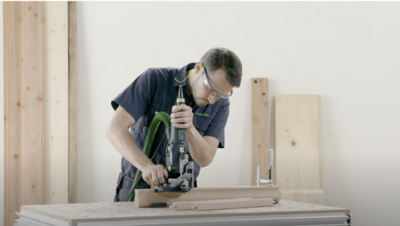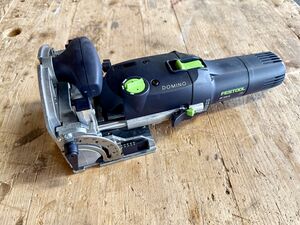Loose Tenon Joiner: Difference between revisions
No edit summary |
donation link |
||
| (9 intermediate revisions by 2 users not shown) | |||
| Line 1: | Line 1: | ||
{{Wanted | |||
|info=Please donate to our [https://www.betterplace.org/de/projects/99816-verbesserung-einer-offenen-werkstatt betterplace campaign] if you want to make this wish come true. | |||
}} | |||
Festool's "Domino" joiners are woodworking machines specialized in cutting holes for [[Material:Loose Tenons|loose tenons]] (similar to large dowels that can not be rotated in the joint). They combine the precision of a [[Doweling Jigs|round dowel]] with the flexibility of a traditional [[Biscuit Joiner|biscuit joiner]], enabling strong and invisible joints in [[Material:Wood|wood]]. | |||
[[File:Domino Df500.png|thumb|400x400px|Example Video [https://www.youtube.com/watch?v=_pMHsrqdFas]]] | |||
== Applications: == | |||
A Domino joiner is ideal for panel joints, frame joints, frame connections, and drawer joints. With dowel sizes ranging from 4 x 20 mm to 10 x 50 mm, it offers versatile application options. | |||
The unique Domino system employs mortise and tenon joinery to deliver robust and precise connections. Here are some of the most common connection options that can be achieved using a Domino joiner: | |||
# '''Edge-to-Edge Joints''': | |||
#* '''Application''': Ideal for assembling tabletops, panels, and furniture sides. | |||
#* '''Description''': The Domino DF 500 creates mortises along the edges of two workpieces, where Dominos (tenons) are inserted to join them. This method provides a strong, aligned joint that resists twisting and separation. | |||
# '''Corner Joints''': | |||
#* '''Application''': Common in constructing frames, cabinets, and carcasses. | |||
#* '''Description''': Mortises are cut into the ends and faces of the workpieces to be joined at right angles. The Dominos inserted into these mortises create a stable and precise corner joint, enhancing the structural integrity of the project. | |||
# '''T-Joints''': | |||
#* '''Application''': Used in joining horizontal and vertical components, such as in shelving units or table aprons. | |||
#* '''Description''': Mortises are milled into the face of one workpiece and the edge of another. The Dominos inserted create a strong T-shaped connection, ensuring stability and durability in the assembly. | |||
# '''Miter Joints''': | |||
#* '''Application''': Perfect for creating frames, moldings, and decorative boxes. | |||
#* '''Description''': Mortises are cut at an angle, typically 45 degrees, into the mitred ends of the workpieces. The Dominos fit snugly into these angled mortises, resulting in a clean and precise miter joint that enhances the aesthetic appeal while providing structural strength. | |||
# '''Frame Joints''': | |||
#* '''Application''': Used in the construction of door frames, window frames, and picture frames. | |||
#* '''Description''': Mortises are created in the ends and edges of frame components. Dominos are inserted to join the pieces at right angles, ensuring a rigid and square assembly that resists racking and warping. | |||
# '''Butt Joints''': | |||
#* '''Application''': Useful for joining workpieces end-to-face, such as attaching rails to legs. | |||
#* '''Description''': Mortises are cut into the face of one workpiece and the end of another. The Dominos provide a strong and reliable butt joint, which is superior to traditional methods that rely on screws or nails alone. | |||
# '''Detachable Connection''': | |||
#* Many connections can by made detachable, using one of these [https://www.festool.de/zubehoer/verbinden/zubehoer-fuer-verbinden/domino-verbinder?srsltid=AfmBOooiNH_Plw4ich3S8nbWBBCEclyrN3A6Tj_45gBevmJXkU3XIJBU special joints]. | |||
== DIY Alternatives == | |||
The original machines are very expensive, so here are some alternatives to consider: | |||
* the "Multidübler" jig for a regular [[Handheld Router|handheld router]] can be fitted with a Domino template as described in [https://www.holzwerken.net/produkt/holzwerken-77-januar-februar-2019/ HolzWerken #77]! | |||
* [https://www.instructables.com/NOPEINO-the-Loose-Tenon-Dominoes-Jig/ NOPEINO (Instructables)] seems very similar but with completely open instructions | |||
<!-- NOTE: The following block "imports" content from separate pages - please don't change the code! To edit the actual information, please go back and click "edit" next to the section headline you are interested in :-) --> | |||
{{#ask: | |||
[[MachineType::Domino Joiner]] | |||
|order=descending | |||
|format=embedded | |||
|embedonly=yes | |||
}} | |||
[[Category:Joinery]] | |||
[[Category:Woodworking]] | |||
[[ | |||
Revision as of 14:04, 14 February 2025
This is a wish list page - we don't have this tool yet! Please donate to our betterplace campaign if you want to make this wish come true.
Festool's "Domino" joiners are woodworking machines specialized in cutting holes for loose tenons (similar to large dowels that can not be rotated in the joint). They combine the precision of a round dowel with the flexibility of a traditional biscuit joiner, enabling strong and invisible joints in wood.

Applications:
A Domino joiner is ideal for panel joints, frame joints, frame connections, and drawer joints. With dowel sizes ranging from 4 x 20 mm to 10 x 50 mm, it offers versatile application options.
The unique Domino system employs mortise and tenon joinery to deliver robust and precise connections. Here are some of the most common connection options that can be achieved using a Domino joiner:
- Edge-to-Edge Joints:
- Application: Ideal for assembling tabletops, panels, and furniture sides.
- Description: The Domino DF 500 creates mortises along the edges of two workpieces, where Dominos (tenons) are inserted to join them. This method provides a strong, aligned joint that resists twisting and separation.
- Corner Joints:
- Application: Common in constructing frames, cabinets, and carcasses.
- Description: Mortises are cut into the ends and faces of the workpieces to be joined at right angles. The Dominos inserted into these mortises create a stable and precise corner joint, enhancing the structural integrity of the project.
- T-Joints:
- Application: Used in joining horizontal and vertical components, such as in shelving units or table aprons.
- Description: Mortises are milled into the face of one workpiece and the edge of another. The Dominos inserted create a strong T-shaped connection, ensuring stability and durability in the assembly.
- Miter Joints:
- Application: Perfect for creating frames, moldings, and decorative boxes.
- Description: Mortises are cut at an angle, typically 45 degrees, into the mitred ends of the workpieces. The Dominos fit snugly into these angled mortises, resulting in a clean and precise miter joint that enhances the aesthetic appeal while providing structural strength.
- Frame Joints:
- Application: Used in the construction of door frames, window frames, and picture frames.
- Description: Mortises are created in the ends and edges of frame components. Dominos are inserted to join the pieces at right angles, ensuring a rigid and square assembly that resists racking and warping.
- Butt Joints:
- Application: Useful for joining workpieces end-to-face, such as attaching rails to legs.
- Description: Mortises are cut into the face of one workpiece and the end of another. The Dominos provide a strong and reliable butt joint, which is superior to traditional methods that rely on screws or nails alone.
- Detachable Connection:
- Many connections can by made detachable, using one of these special joints.
DIY Alternatives
The original machines are very expensive, so here are some alternatives to consider:
- the "Multidübler" jig for a regular handheld router can be fitted with a Domino template as described in HolzWerken #77!
- NOPEINO (Instructables) seems very similar but with completely open instructions
Festool Domino DF 500
| MachineInfoBox Domino DF 500 | |
|---|---|

| |
| Synonyms: | DE: Dübelfräse |
| Type: | Loose Tenon Joiner |
| Material: | Wood |
| Used with: | loose tenons |
| Location: | Saw Station |
| Access Requirements: | Joinery Machine Introduction |
| Status: | Working |
| Manual: | bedienungsanleitu.ng (DE/EN); festoolusa.com (EN) |
| Tutors: | Lukas Pakue Baumphil |
| Similar (More or Less): | Biscuit Joiner |
The Festool Domino DF 500 is a high-precision Domino joiner. The available router bits we have for this machine are 5mm, 6mm and 8mm. The routers are stored in our loose tenonsstorage box
Key Features
- Pendulum Milling Principle: This unique milling principle allows for precise and effortless work.
- Adjustable Settings: Moveable step stop for height and preset adjustment for standard material thicknesses, as well as milling height adjustment with a scale ranging from 5 to 30 mm.
- Milling Angle: Mitre milling from 0 to 90° with locking positions at 0°, 22.5°, 45°, 67.5°, and 90°.
- Dust Extraction Connection: Ø 27 mm, ensuring clean working conditions.
- Product Weight: 3.5 kg without accessories.
Workflow

Changing the router tool
- Lift the unlocking lever [1-3] until it audibly engages with the fork wrench.
- Separate the motor unit and the guide frame. Press and hold in the spindle lock. Release and unscrew the jointer bit with the fork wrench. Release the spindle lock. Insert the new router tool and reassemble the Domino DF-500.
Adjusting the milling depth
- Open the notch lever lock [1‑8] by pressing it.
- Use the locking lever [1‑7] to set the desired jointing depth (12 mm, 15 mm, 20 mm, 25 mm, 28 mm). For the jointer bit with a diameter of 5 mm, only jointing depths of 12 mm, 15 mm and 20 mm are permitted due to its short shank length.
- Release the notch lever lock again. A special cutter is available for the DOMINO dowel 4x20 mm (due to risk of breakage). Note the following when using this cutter (D 4-NL 11 HW-DF 500): Set the routing depth to 20 mm using the stop lever [1‑7]. The actual routing depth is 10 mm. The dowel can only be positioned centrally.
Setting jointing height
a) with selection slide
- Release the clamping lever for jointing height adjustment. Using the additional handle, raise the front section of the guide frame. Use the slide [1‑6] to set the desired board thickness (16 mm, 20 mm, 22 mm, 25 mm, 28 mm, 36 mm, 40 mm).
- Press the front section of the guide frame downwards as far as the stop. Close the clamping lever.
b) freely selectable
- Release the clamping lever for jointing height adjustment. Using the additional handle, raise the front section of the guide frame. Push the slide to the stop in direction motor unit. Set the desired jointing height using the scale by moving the front section of the guide frame vertically. Close the clamping lever.
Setting dowel-hole width
Reliable setting of the dowel-hole width with the rotary switch [1‑2] is only possible with the machine running! The following dowel-hole settings are possible:
- 13 mm + jointer bit diameter
- 19 mm + jointer bit diameter
- 23 mm + jointer bit diameter
Cleanup
Once you are done, ensure the Domino gets properly stored in its box as shown in the picture:

Additional stop with extension

The additional stop can be used to enlarge the contact surface when jointing on the workpiece edge, thus allowing safer guidance of the machine. The distance to the centre of the routed hole can be reduced from 37 mm to 20 mm using the two integral stop spacers, allowing you to position the dowel closer to the edge.
- Secure the additional stop to the threaded bores on the guide frame using both screws, whereby the contact areas of the support ring and the table must be level with one another.
- Swivel one of the distance spacers outwards to reduce the distance. The spacer aligns automatically with the stop latch.
Instruction Videos:
Joining small parts using the additional extension